KL-10
This is sort of the "holy grail" for many DEC collectors. I had
been offered a VAX 11/780 by someone, but it was more $'s than I
really wanted to spend for something that was big and required
3-phase power. I was relating the story to a fellow DEC
collector when I mentioned that the only system that I'd really deal
with 3-phase would be a KL-10. His comment was "I have one and
I'd be willing to part with it for the right price". Half
teasing (figuring the right price was a lot), I said sure, let me know
what you want and we'll see if we can't make a deal. Was I
suprised when he came back a few days later with a figure that seemed
(to me anyway) reasonable.
To be honest, this will be the most difficult of any of the systems I
have to bring back. At some point in it's life it had been
stored in a barn and was home to some number of critters. Most
of the remants of occupation had been removed but the system is not
in a functional state.
Some technical information about PDP-10's can be found here. From what I can tell, my KL-10
is a 1090(PV). This seems to indicate that it has a 23-bit
virtual address space with a 22-bit physical memory space. I
think it also runs at 30MHz rather than the 25MHz of the 1090(PA) model
(which only has an 18-bit virtual address space).
Yesterday (6/7/2003) we moved the KL-10 from the previous owner's
warehouse to my storage area. It took all day! It was
especially difficult since several (many) of the casters had ceased
performing their primary function (they no longer rotate). These
cabinets are heavy! But after many hours of pushing
and shoving (literally) the KL-10 was relocated to its (temporary)
new home.
Here is a shot of the entire system. Going from left to right (or
front to back?) are the CPU cabinet, I/O cabinet, front-end
processor (an 11/40!!) and two AMPEX memory boxes.
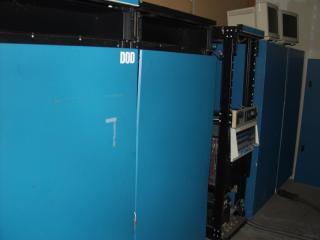
Here's a better shot of the front-end processor.
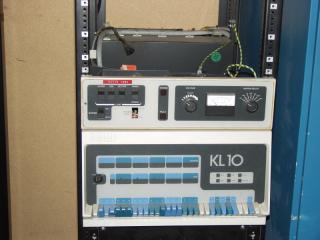
One of the reasons why this is going to be a difficult
restoration (other than there's a lot to do) is because it requires
(a lot of) 3-phase power. You won't find an adapter for this at
Home Depot!
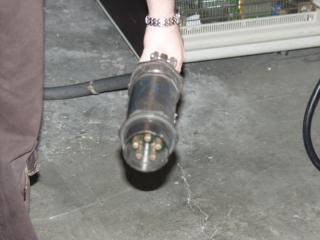
Here's a comparison with the KL-10's power connector with a standard
120v 15a 3 prong connector.
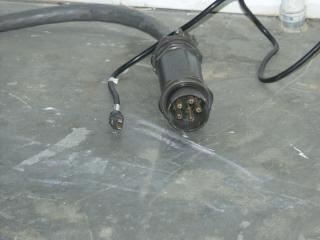
The AMPEX memory boxes appear to be a total writeoff. At some
urging (encouragement?) it was suggested that a better solution would
be
to design and build a custom memory card using somewhat modern memory
chips that would plug right into the processor. This would
probably be the easiest solution in addition to reducing the power
requirements considerably.
The next step will be to dig into it a bit to see what it is I actually
have so that a more detailed plan of attack can be arrived at.
6/8/2003 Update
I just couldn't wait! I went back and took some more pictures
while opening everything up.
11/40 Front End Processor
Here's the 11/40 front-end processor's backplane.
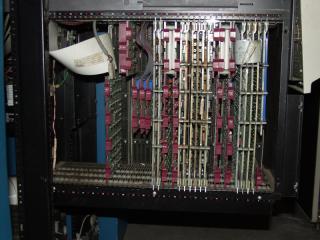
KL10 PV
Here are a few pictures of the KL-10 cpu and power supplies.
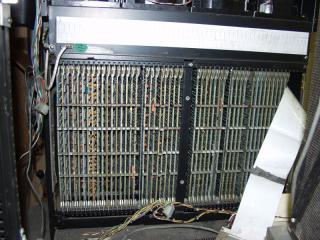
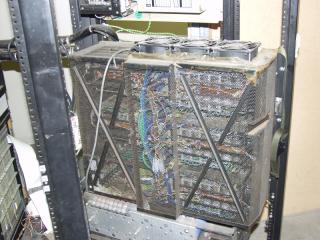
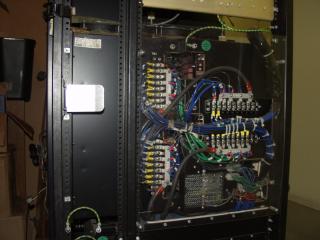
I/O Cabinet
Here are a few pictures of the I/O cabinet's backplane and power
supplies.
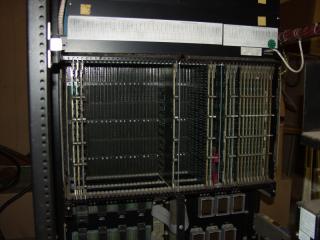
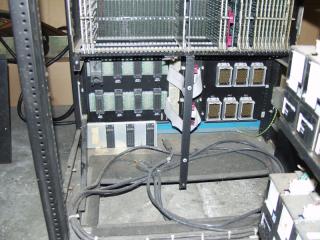
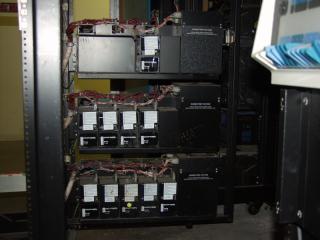
It's a bit hard to tell, but the I/O cabinet contains a DMA20, a DIA20,
a single DTE20 (it can hold upto 4) and a single RH20 (it can hold upto
8).
The DMA20 is responsible for interfacing to external memory. It
adapts the S-Bus from the KL-10 processor into 4 seperate K-buses to
allow for upto 4 word transfers and 4 way interleaving of storage
modules.
The DIA20 is responsible for interfacing the KL-10 processor's E-bus to
the external I/O bus. It is the default controller on the E-bus
so if neither a DTE20 nor an RH20 responds to the E-bus dialog, the
DIA20 will pass it along on the I/O bus to allow one of the devices on
that bus to respond (sort of like PCI subtractive decode).
The DTE20 interfaces the KL-10 processor's E-bus to the front end (or
console) processor.
The RH20 is a Massbus interface which provides access to mass storage
devices such as disks and tapes to the KL-10's E-bus and C-bus (channel
bus).











